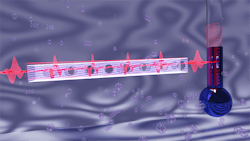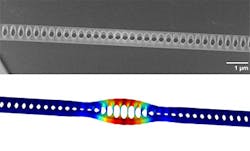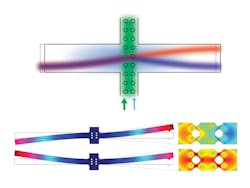Combining Mechanics and Optics to Build a Quantum Thermometer
In a marriage of optics and mechanics, physicists at the National Institute of Standards and Technology (NIST) have built microscopic structural beams that serve as thermometers and could be used in optical heat shields. The devices, which operate in room-temperature environments, rely on quantum physics. Potential applications include chip-based temperature sensors that never need to be adjusted because they rely on fundamental constants of nature, tiny refrigerators that can cool state-of-the-art microscope components, and improved “metamaterials” that would let researchers manipulate light and sound in new ways.
The beams are made of silicon nitride, a widely used material in the electronics and photonics industries, and are about 20 microns (20 millionths of a meter) long. They are transparent, with a row of holes drilled through them to enhance their optical and mechanical properties.
“You can send light down this beam because it’s transparent,” explains Tom Purdy, a NIST physicist who is an author on both papers.
To use the beam as a thermometer, researchers must be able to measure the tiniest possible vibrations in the beam. The amount that the beam vibrates is proportional to the temperature of its surroundings.
The vibrations come from two kinds of sources. The first are ordinary “thermal” sources such as gas molecules buffeting the beam or sound waves passing through it. The second source comes purely from the world of quantum mechanics, the theory that governs behavior of matter at the atomic scale. The quantum behavior occurs when the researchers send particles of light, or photons, down the beam. When struck by light, the mechanical beam reflects the photons and recoils in the process, creating small vibrations in the beam. Sometimes these quantum-based effects are described using the Heisenberg uncertainty relationship: The photon bounce leads to information about the beam’s position, but because it imparts vibrations to the beam, it adds uncertainty to the beam’s velocity.
“The quantum mechanical fluctuations give us a reference point because essentially you can't make the system move less than that,” says Jake Taylor, a researcher at the Joint Quantum Institute, which is spearheading the research.
By plugging in values of Boltzmann’s and Planck’s constants, the researchers calculate the temperature. And given that reference point, they can measure more motion in the beam, such as from thermal sources, and accurately extrapolate the temperature of the environment. However, the quantum fluctuations are a million times fainter than the thermal vibrations; detecting them is like hearing a pin drop while taking a shower.
In their experiments, the team used a state-of-the-art silicon nitride beam built at NIST’s Center for Nanoscale Science and Technology. By shining high-quality photons at the beam and analyzing photons emitted from the beam shortly thereafter, the team could detect some of the quantum vibrational motion picked up in the output of light. Their measurements are now sensitive enough to see these quantum effects all the way up to room temperature for the first time.
At top is an electron micrograph of a silicon nitride beam which can act as a highly accurate "quantum thermometer" through measurements of its tiniest vibrations. The bottom shows how the beam deforms as it vibrates (length scale greatly exaggerated) with the red regions showing the most deformation, and the blue regions not moving at all. (Credit: Purdy et al., NIST/JQI)
The researchers go in the opposite direction in a second proposed application for the beams.
Instead of having heat hit the beam and letting it serve as a temperature probe, the researchers propose using the beam to divert the heat, such as from sensitive parts of an electromechanical device.
Schematic (top) and simulation (bottom) show an optomechanical device that takes advantage of optical cooling. Light travels through the series of holes with a chance to reflect back towards its source that depends on the motion of the two ‘arms’ of the mechanical system. Laser cooling damps the motion in which the arms move in opposite directions and this improves the performance of the symmetrical moving mode (arms in synchrony). This symmetrical mode is, in turn, modified by interactions between the small tip and a nearby surface, letting it optically detect surface properties in a standard atomic force microscope setup. (Credit: Xu et al./NIST and University of Maryland)
In their proposed setup, the researchers enclose the beam in a cavity with a pair of mirrors that bounce light back and forth. They use light to control the vibrations of the beam so that the beam cannot re-radiate incoming heat in its usual direction, which is toward a colder object.
For this application, Taylor likens the behavior of the beam to a tuning fork. When you hold a tuning fork and strike it, it radiates pure sound tones instead of letting that motion turn to heat and travel down the fork and into your hand. “A tuning fork rings for a long time, even in air,” he says. “The two fork prongs vibrate in opposite directions and cancel out a way for energy to leave the bottom of the fork through your hand.”
The researchers envision using an optically controlled silicon nitride beam as the tip of an atomic force microscope (AFM), which detects forces on surfaces to build up atom-scale images. An optically controlled AFM tip would perform better if it stayed cool.
“You’re removing thermal motion, which makes it easier to see signals,” Taylor explains.
This technique could also be put to use making improved metamaterials, complex composite objects that manipulate light or sound in new ways and could be used to make better lenses or even so-called “invisibility cloaks” that send certain wavelengths of light around an object rather than bouncing off of it.
“Metamaterials are our answer to the question, ‘How do we make materials that capture the best properties for light and sound, or for heat and motion?’” according to Taylor. “It’s a technique that has been widely used in engineering, but combining light and sound together remains still a bit open on how far we can go with it, and this provides a new tool for exploring that space.”
The research was performed by a team led by the Joint Quantum Institute (JQI), a research collaboration of the National Institute of Standards and Technology (NIST) and the University of Maryland.



